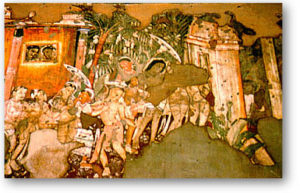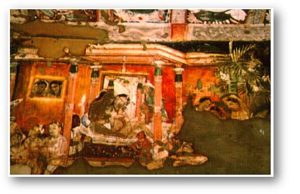The cave temples of Ajanta are situated about sixty two miles north of Aurangabad in western India. The caves are first mentioned in the writings of the Chinese pilgrim Hiuen Tsang who visited India between A.D 629 and 645. The caves were “discovered” dramatically during the course of military manouevres being undertaken by British officers in 1819. Public attention was roused and the East India company instructed the Viceroy to procure good copies of the paintings. Publicity, however, was nearly fatal to the original paintings, as many archaeologists and officials cut out the heads to be presented to museums. Therefore, in 1903, wire screens were fixed in all the important caves.
The thirty temples at Ajanta are set into the rocky sides of a crescent shaped gorge in the Inhyadri hills of the Sahyadri ranges. At the head of the gorge is a natural pool fed by a waterfall. Though this pristine spot was chosen to enable the Buddhist monks to meditate undisturbed, it should be noted that all sites of Buddhist excavations were situated close to the main trade routes.
Fresco at Ajanta
The excavations span a period of about six centuries. The earlier monuments include both chaitya halls (halls divided into a central nave and side aisles by two rows of columns) and monasteries. These date from the 2nd to 1st centuries B.C. After a period of more than six centuries, excavations once again revived during the Vakataka ruler Harishena. The sculptures contain an impressive array of votive figures, accessory figures, narrative episodes and decorative motifs. The series of paintings is unparalleled in the history of Indian art, both for the wide range of subjects and the medium. A large number of incidents from the life of the Buddha are depicted. Tales from the Jataka legends were executed vibrantly by large scale compositions depicting life in court, town or forest. Overlapping figures suggest perspective, colors are harmoniously blended, and the linework is sinuous. However, the identities of the artists responsible for the execution of the Ajanta caves are unknown. This is not only a testimony to their extraordinary faith in the Buddha, but is characteristic of Indian traditions of anonymity and abnegation of self. Even today, these cave temples at Ajanta provide the most complete illustration of Buddhist tradition.
Sources
Brown, Percy. Indian Architecture. Bombay: Taraporevala and co., 1959.
Michell, George. The Penguin guide to the monuments of India, Vol I. London: Viking, 1989.
Tadgell, Christopher. The History of Architecture in India. London: Phaidon Press, 1990.
Gupte, Ramesh; and Mahajan, B. D. Ajanta, Ellora and Aurangabad Caves. Bombay: Taraporevala and co., 1962.


